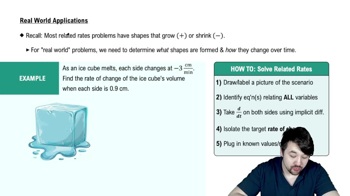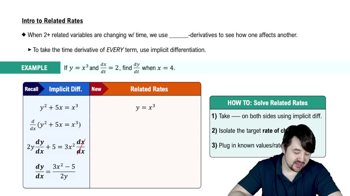Table of contents
- 0. Functions7h 52m
- Introduction to Functions16m
- Piecewise Functions10m
- Properties of Functions9m
- Common Functions1h 8m
- Transformations5m
- Combining Functions27m
- Exponent rules32m
- Exponential Functions28m
- Logarithmic Functions24m
- Properties of Logarithms34m
- Exponential & Logarithmic Equations35m
- Introduction to Trigonometric Functions38m
- Graphs of Trigonometric Functions44m
- Trigonometric Identities47m
- Inverse Trigonometric Functions48m
- 1. Limits and Continuity2h 2m
- 2. Intro to Derivatives1h 33m
- 3. Techniques of Differentiation3h 18m
- 4. Applications of Derivatives2h 38m
- 5. Graphical Applications of Derivatives6h 2m
- 6. Derivatives of Inverse, Exponential, & Logarithmic Functions2h 37m
- 7. Antiderivatives & Indefinite Integrals1h 26m
- 8. Definite Integrals3h 25m
4. Applications of Derivatives
Related Rates
Problem 3.6.3
Textbook Question
Complete the following statement. If dy/dx is small, then small changes in x will result in relatively ______ changes in the value of y.
 Verified step by step guidance
Verified step by step guidance1
Understand that dy/dx represents the derivative of y with respect to x, which indicates the rate of change of y as x changes.
Recognize that if dy/dx is small, it means that the slope of the tangent line to the curve at that point is close to zero.
Interpret that a small slope implies that for small changes in x (denoted as dx), the corresponding changes in y (denoted as dy) will also be small.
Conclude that small changes in x will lead to relatively small changes in the value of y, as the derivative indicates how sensitive y is to changes in x.
Fill in the blank with the word 'small' to complete the statement: If dy/dx is small, then small changes in x will result in relatively small changes in the value of y.
Recommended similar problem, with video answer:
 Verified Solution
Verified SolutionThis video solution was recommended by our tutors as helpful for the problem above
Video duration:
3mPlay a video:
Was this helpful?
Related Videos
Related Practice






